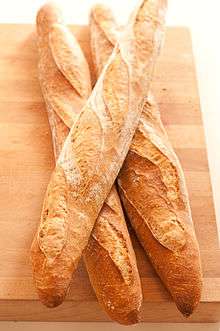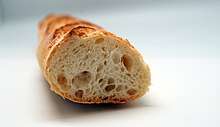Baguette
 | |
| Alternative names | French stick, French loaf or French Bread |
|---|---|
| Type | Bread |
| Course | Starter or Main |
| Place of origin | France |
| Created by | Unknown |
| Main ingredients | Flour, water, yeast, salt |
| Variations | Bánh mì |
| 263 kcal (1101 kJ) | |
| Other information | glycaemic load 47 (100g)[1] |
A baguette (/bæˈɡɛt/; French: [baˈɡɛt]) is a long, thin loaf of French bread[2] that is commonly made from basic lean dough (the dough, though not the shape, is defined by French law). It is distinguishable by its length and crisp crust.
A baguette has a diameter of about 5 or 6 cm (2-2⅓ in) and a usual length of about 65 cm (26 in), although a baguette can be up to 1 m (39 in) long.
History
No academic study has been written on the history of the baguette itself, as a type of bread.[3] Thus, much of its history is speculative; however, some facts can be established. Among these are the increased popularity of long, stick-like breads in France starting in the 18th century,[4] the shift among French bakers to using "gruau", a highly refined Hungarian high-milled flour in the early 19th century,[5] the introduction of Viennese steam oven baking to Paris in 1839 by August Zang,[6] and the subsequent introduction of the Austrian Adolf Ignaz Mautner von Markhof's compact yeast to Paris in 1867 at the Universal Exposition.[7] Finally, there is the first use of the word "baguette" in print, to define a particular type of bread, in a set of laws enacted by the Prefecture of the Seine Department in August 1920: "The baguette, having a minimum weight of 80 g and a maximum length of 40 cm, may not be sold for a price higher than 0.65 francs apiece"[8] While no one of these events is in itself definable as "the invention of the baguette", each of them, the shape, the flour, the fermentation, and the steam baking, contribute to what is today recognized as a "baguette".
To summarize this history, the historian and author Jim Chevallier states that "it seems most accurate to say that the bread which became known as the baguette first appeared in its most primitive form in the eighteenth century, then experienced a number of refinements and variations before being (officially) given that name in 1920."[9]
Although the word "baguette" was not used to refer to a type of bread until 1920,[10] the word itself simply means "wand", "baton" or "stick", as in baguette magique (magic wand), baguettes chinoises (chopsticks), or baguette de direction (conductor's baton).
Though the baguette today is often considered one of the symbols of French culture viewed from abroad, the association of France with long loaves predates any mention of it. Long, wide, loaves had been made since the time of King Louis XIV, long thin ones since the mid-18th century, and by the 19th century, some were far longer than what is today sold as a baguette: "... loaves of bread six feet long that look like crowbars!" (Boswell, 1862);[11] "Housemaids were hurrying homewards with their purchases for various Gallic breakfasts, and the long sticks of bread, a yard or two in length, carried under their arms, made an odd impression upon me." (Elson, 1898)[12]
A less direct link can be made, however, with deck ovens, or steam ovens. Deck/steam ovens are a combination of a gas-fired traditional oven and a brick oven, a thick "deck" of stone or firebrick heated by natural gas instead of wood. The first steam oven was brought (in the early 19th century) to Paris by the Austrian officer August Zang, who also introduced Vienna bread (pain viennois) and the croissant, and whom some French sources thus credit with originating the baguette.[13]
Deck ovens use steam injection, through various methods, to create the proper baguette. The oven is typically heated to well over 200 °C (390 °F). The steam allows the crust to expand before setting, thus creating a lighter, airier loaf. It also melts the dextrose on the bread's surface, giving a slightly glazed effect.
An unsourced article in The Economist states that in October 1920 a law prevented bakers from working before 4 am, making it impossible to make traditional round loaves in time for customers' breakfasts. Switching from the round loaf to the previously less-common, slender shape of the baguette, the article claims, solved the problem, because it could be prepared and baked much more quickly.[14]
The law in question appears to be one from March 1919, though some say it took effect in October 1920:
It is forbidden to employ workers at bread and pastry making between ten in the evening and four in the morning.[15]
The rest of the account remains to be verified, but the use of the word for a long thin bread does appear to be a 20th-century innovation.
Manufacture and styles

The "baguette de tradition française" is made from wheat flour, water, yeast, and common salt. It may contain up to 2% broad bean flour, up to 0.5% soya flour, and up to 0.3% wheat malt flour.[16]
While a regular baguette is made with a direct addition of baker's yeast, artisan-style loaves are not unusually made with a preferment (poolish) to increase flavor complexity and other characteristics, as well as the addition of whole-wheat flour, or other grains such as rye.
Baguettes are closely connected to France, though they are made around the world. In France, not all long loaves are baguettes; for example, a short, almost rugby ball-shaped loaf is a bâtard (literally, bastard), or a "torpedo loaf" in English; its origin is variously explained, but undocumented. Another tubular shaped loaf is known as a flûte, also known in the United States as a parisienne. Flûtes closely resemble baguettes and weigh more or less than these, depending on the region. A thinner loaf is called a ficelle (string). A short baguette is sometimes known as a baton (stick), or even referred to using the English translation French stick. None of these are officially defined, either legally or, for instance, in major dictionaries, any more than the baguette. French breads are also made in forms such as a miche, which is a large pan loaf, and a boule, literally ball in French, a large round loaf. Sandwich-sized loaves are sometimes known as demi-baguettes or tiers.
In France a baguette must weigh 250 grams (8.75 ounces), a batard 500 grams (17.5 ounces) and a ficelle 100 grams (3.5 ounces). Baguettes, either relatively short single-serving size or cut from a longer loaf, are very often used for sandwiches, usually of the submarine sandwich type, but also a Panini. They are often sliced and served with pâté or cheese. As part of the traditional continental breakfast in France, slices of baguette are spread with butter and jam and dunked in bowls of coffee or hot chocolate. In the United States, French bread loaves are sometimes split in half to make French bread pizza.
Baguettes are generally made as partially free-form loaves, with the loaf formed with a series of folding and rolling motions, raised in cloth-lined baskets or in rows on a flour-impregnated towel, called a couche, and baked either directly on the hearth of a deck oven or in special perforated pans designed to hold the shape of the baguette while allowing heat through the perforations. American-style "French bread" is generally much fatter and is not baked in deck ovens, but in convection ovens.
Outside France, baguettes are also made with other doughs. For example, the Vietnamese bánh mì uses a high proportion of rice flour, while many North American bakeries make whole wheat, multigrain, and sourdough baguettes alongside French-style loaves. In addition, even classical French-style recipes vary from place to place, with some recipes adding small amounts of milk, butter, sugar, or malt extract, depending on the desired flavour and properties in the final loaf.
See also
References
- ↑ http://www.health.harvard.edu/diseases-and-conditions/glycemic_index_and_glycemic_load_for_100_foods
- ↑ Merriam-Webster's Collegiate Dictionary, 11th Edition
- ↑ Jim Chevallier (15 March 2014). About the Baguette: Exploring the Origin of a French National Icon. Createspace Independent Pub. p. 35. ISBN 978-1-4973-4408-2.
- ↑ Jim Chevallier (15 March 2014). About the Baguette: Exploring the Origin of a French National Icon. Createspace Independent Pub. p. 5. ISBN 978-1-4973-4408-2.
- ↑ Jim Chevallier (15 March 2014). About the Baguette: Exploring the Origin of a French National Icon. Createspace Independent Pub. p. 13. ISBN 978-1-4973-4408-2.
- ↑ Jim Chevallier (15 March 2014). About the Baguette: Exploring the Origin of a French National Icon. Createspace Independent Pub. p. 12. ISBN 978-1-4973-4408-2.
- ↑ Jim Chevallier (15 March 2014). About the Baguette: Exploring the Origin of a French National Icon. Createspace Independent Pub. p. 14. ISBN 978-1-4973-4408-2.
- ↑ texte, Seine Auteur du (August 1920). Recueil des actes administratifs de la Préfecture du département de la Seine. Paris: Préfecture du département de la Seine.
- ↑ Jim Chevallier (15 March 2014). About the Baguette: Exploring the Origin of a French National Icon. Createspace Independent Pub. p. 57. ISBN 978-1-4973-4408-2.
- ↑ "Le Pain Frais". La Figaro (in French). Paris. 1920-08-04. Retrieved 2018-01-20.
- ↑ Supplement to the Courant, John L. Boswell, pub, 1862, p. 45
- ↑ Louis Charles Elson, European Reminiscences, Musical and Otherwise: Being the Recollections of the Vacation Tours of a Musician in Various Countries, 1898, p. 186
- ↑ "La baguette parisienne". Lepoint.fr. 12 March 2009. Retrieved 2011-09-17.
- ↑ Lynne Olver. "Food Timeline FAQs: bread". Foodtimeline.org. Retrieved 2011-09-17.
- ↑ Bulletin des Lois de la République Française – Nouvelle Série – Année 1919 T.XI:241–264 B. No. 246 (p. 769) – No. 13950
- ↑ "Détail d'un texte" (in French). Legifrance.gouv.fr. Retrieved 2011-09-17.
Further reading
- Child, Julia. From Julia Child's Kitchen. New York: Knopf, 1970.
- Child, Julia and Simone Beck. Mastering the Art of French Cooking, vol. 2. New York: Knopf, 1970.
- Rambali, Paul. Boulangerie. New York: Macmillan, 1994, ISBN 0-02-600865-3.
- Reinhard, Peter. Crust and Crumb. Berkeley, CA: Ten Speed Press, 1998, ISBN 1-58008-802-3.
External links
| Look up baguette in Wiktionary, the free dictionary. |

- About the Baguette – an investigation into the origin of the baguette
- Making traditional French bread: baguettes – Detailed article on how to make traditional baguettes